Major Project in Construction: BIM and Construction Safety Analysis
VerifiedAdded on 2022/08/26
|6
|1209
|22
Report
AI Summary
This report investigates the implications of Building Information Management (BIM) systems in enhancing health and safety within the construction industry. It begins with an executive summary and objective statement, followed by a background study that highlights BIM's capabilities in identifying and mitigating risks on construction sites. The report examines the advantages of BIM, such as automated hazard detection and reduced rework, while also acknowledging its disadvantages, like the cost of implementation and legal constraints. Furthermore, it explores the industrial implications of BIM, emphasizing its role in preventing injuries and fatalities. The report references studies that demonstrate BIM's effectiveness in detecting system failures and improving safety measures. It concludes by emphasizing the need for increased training and knowledge sharing to fully realize the safety benefits of BIM in the construction workplace.
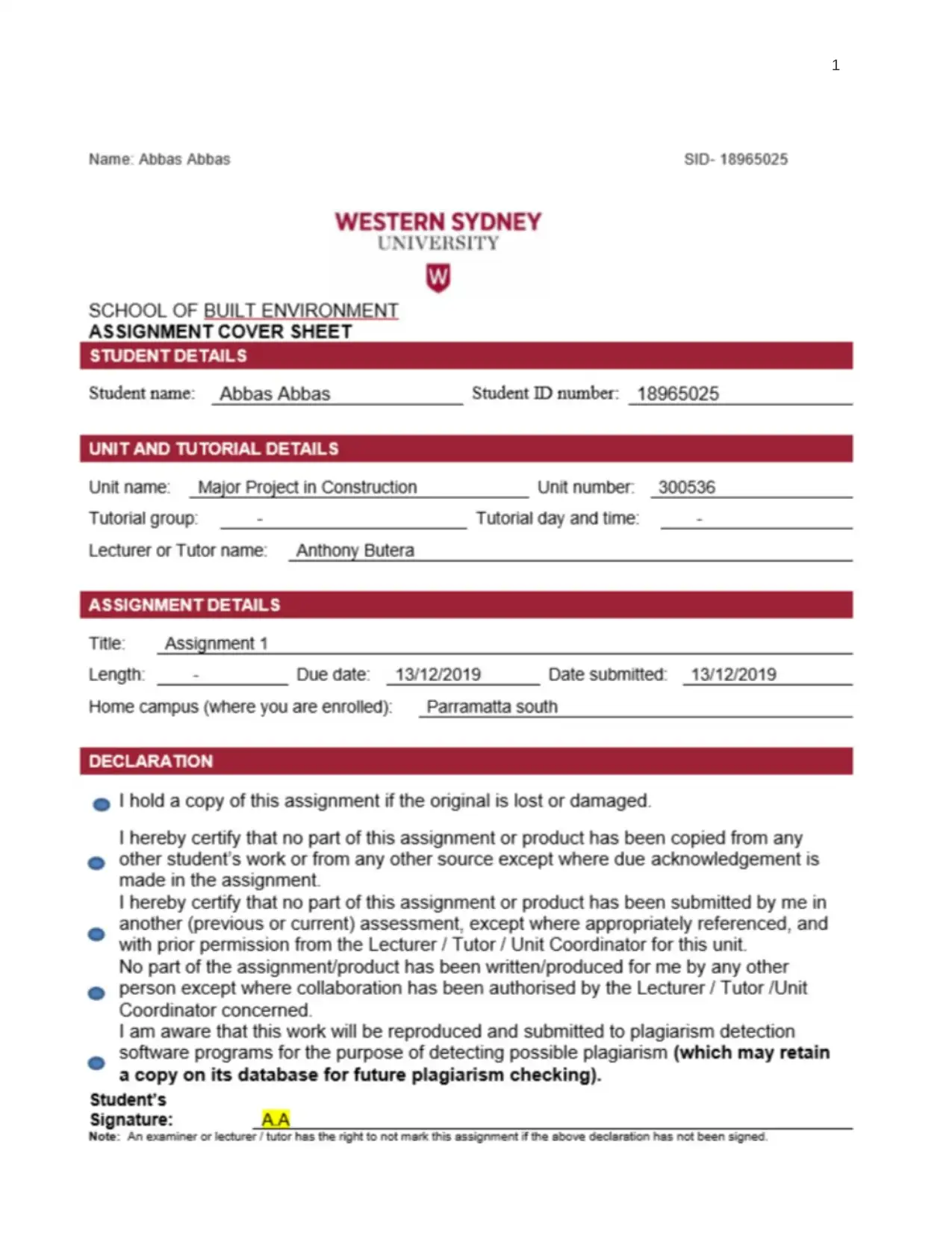
1
Paraphrase This Document
Need a fresh take? Get an instant paraphrase of this document with our AI Paraphraser
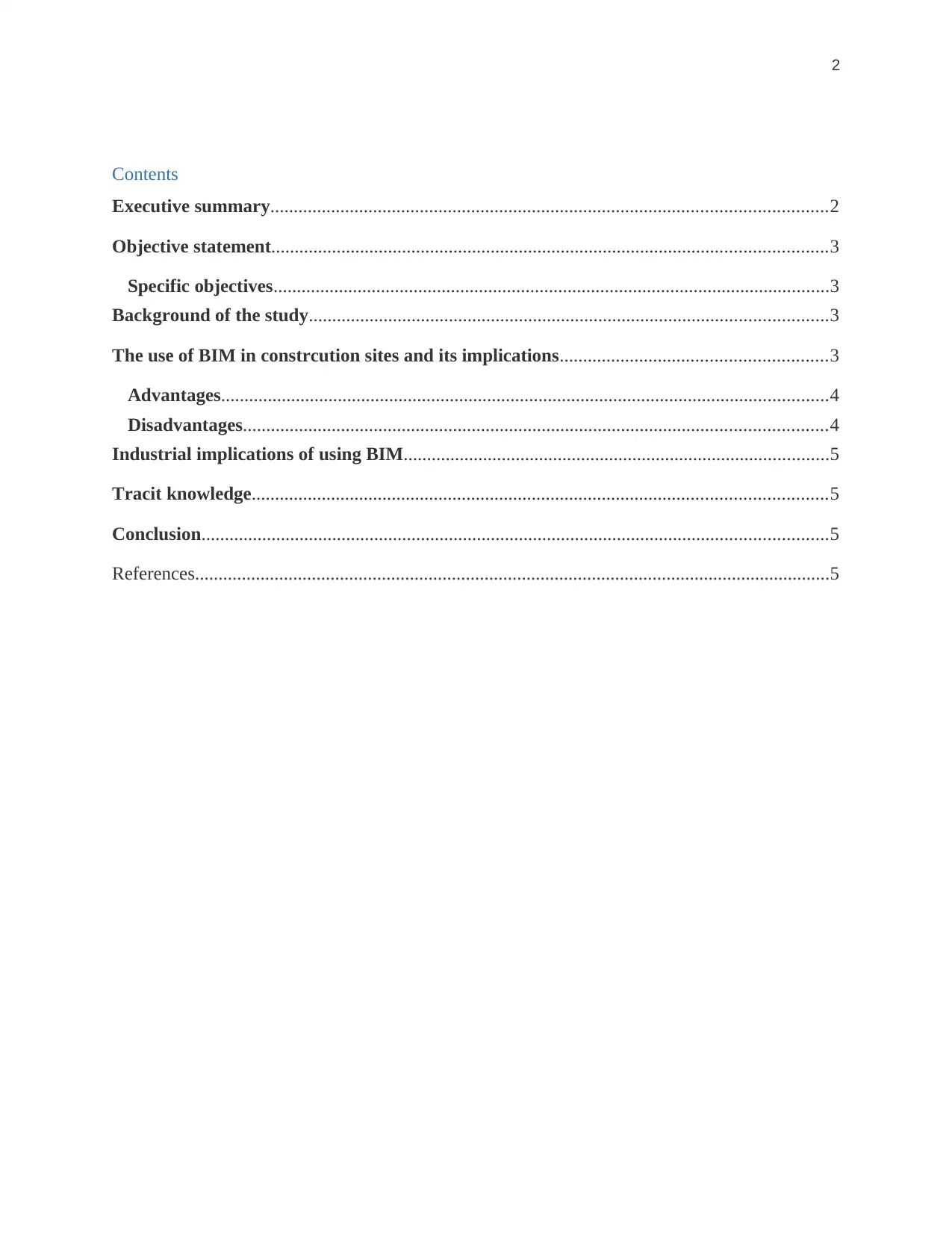
2
Contents
Executive summary.......................................................................................................................2
Objective statement.......................................................................................................................3
Specific objectives.......................................................................................................................3
Background of the study...............................................................................................................3
The use of BIM in constrcution sites and its implications.........................................................3
Advantages..................................................................................................................................4
Disadvantages.............................................................................................................................4
Industrial implications of using BIM...........................................................................................5
Tracit knowledge...........................................................................................................................5
Conclusion......................................................................................................................................5
References........................................................................................................................................5
Contents
Executive summary.......................................................................................................................2
Objective statement.......................................................................................................................3
Specific objectives.......................................................................................................................3
Background of the study...............................................................................................................3
The use of BIM in constrcution sites and its implications.........................................................3
Advantages..................................................................................................................................4
Disadvantages.............................................................................................................................4
Industrial implications of using BIM...........................................................................................5
Tracit knowledge...........................................................................................................................5
Conclusion......................................................................................................................................5
References........................................................................................................................................5
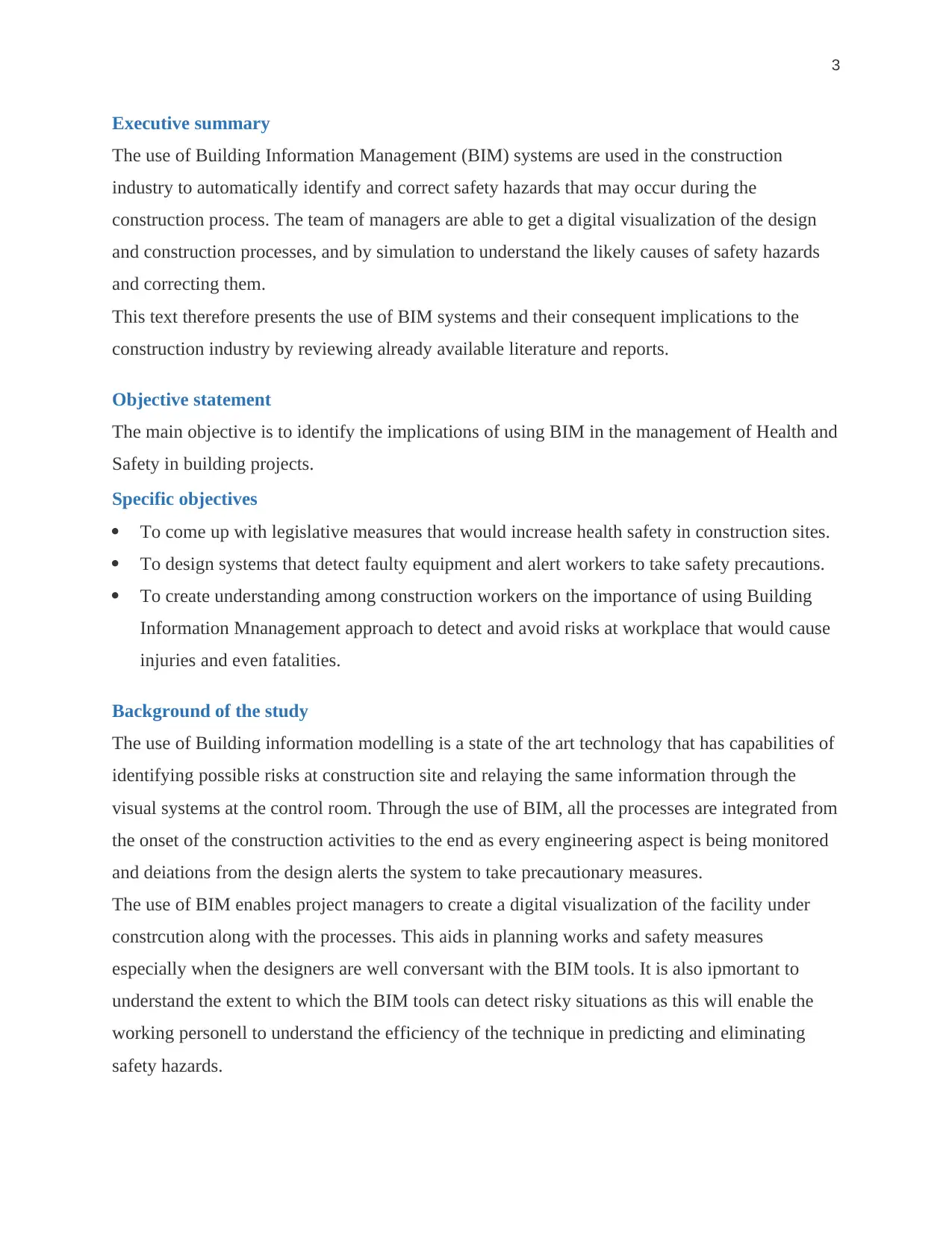
3
Executive summary
The use of Building Information Management (BIM) systems are used in the construction
industry to automatically identify and correct safety hazards that may occur during the
construction process. The team of managers are able to get a digital visualization of the design
and construction processes, and by simulation to understand the likely causes of safety hazards
and correcting them.
This text therefore presents the use of BIM systems and their consequent implications to the
construction industry by reviewing already available literature and reports.
Objective statement
The main objective is to identify the implications of using BIM in the management of Health and
Safety in building projects.
Specific objectives
To come up with legislative measures that would increase health safety in construction sites.
To design systems that detect faulty equipment and alert workers to take safety precautions.
To create understanding among construction workers on the importance of using Building
Information Mnanagement approach to detect and avoid risks at workplace that would cause
injuries and even fatalities.
Background of the study
The use of Building information modelling is a state of the art technology that has capabilities of
identifying possible risks at construction site and relaying the same information through the
visual systems at the control room. Through the use of BIM, all the processes are integrated from
the onset of the construction activities to the end as every engineering aspect is being monitored
and deiations from the design alerts the system to take precautionary measures.
The use of BIM enables project managers to create a digital visualization of the facility under
constrcution along with the processes. This aids in planning works and safety measures
especially when the designers are well conversant with the BIM tools. It is also ipmortant to
understand the extent to which the BIM tools can detect risky situations as this will enable the
working personell to understand the efficiency of the technique in predicting and eliminating
safety hazards.
Executive summary
The use of Building Information Management (BIM) systems are used in the construction
industry to automatically identify and correct safety hazards that may occur during the
construction process. The team of managers are able to get a digital visualization of the design
and construction processes, and by simulation to understand the likely causes of safety hazards
and correcting them.
This text therefore presents the use of BIM systems and their consequent implications to the
construction industry by reviewing already available literature and reports.
Objective statement
The main objective is to identify the implications of using BIM in the management of Health and
Safety in building projects.
Specific objectives
To come up with legislative measures that would increase health safety in construction sites.
To design systems that detect faulty equipment and alert workers to take safety precautions.
To create understanding among construction workers on the importance of using Building
Information Mnanagement approach to detect and avoid risks at workplace that would cause
injuries and even fatalities.
Background of the study
The use of Building information modelling is a state of the art technology that has capabilities of
identifying possible risks at construction site and relaying the same information through the
visual systems at the control room. Through the use of BIM, all the processes are integrated from
the onset of the construction activities to the end as every engineering aspect is being monitored
and deiations from the design alerts the system to take precautionary measures.
The use of BIM enables project managers to create a digital visualization of the facility under
constrcution along with the processes. This aids in planning works and safety measures
especially when the designers are well conversant with the BIM tools. It is also ipmortant to
understand the extent to which the BIM tools can detect risky situations as this will enable the
working personell to understand the efficiency of the technique in predicting and eliminating
safety hazards.
⊘ This is a preview!⊘
Do you want full access?
Subscribe today to unlock all pages.

Trusted by 1+ million students worldwide
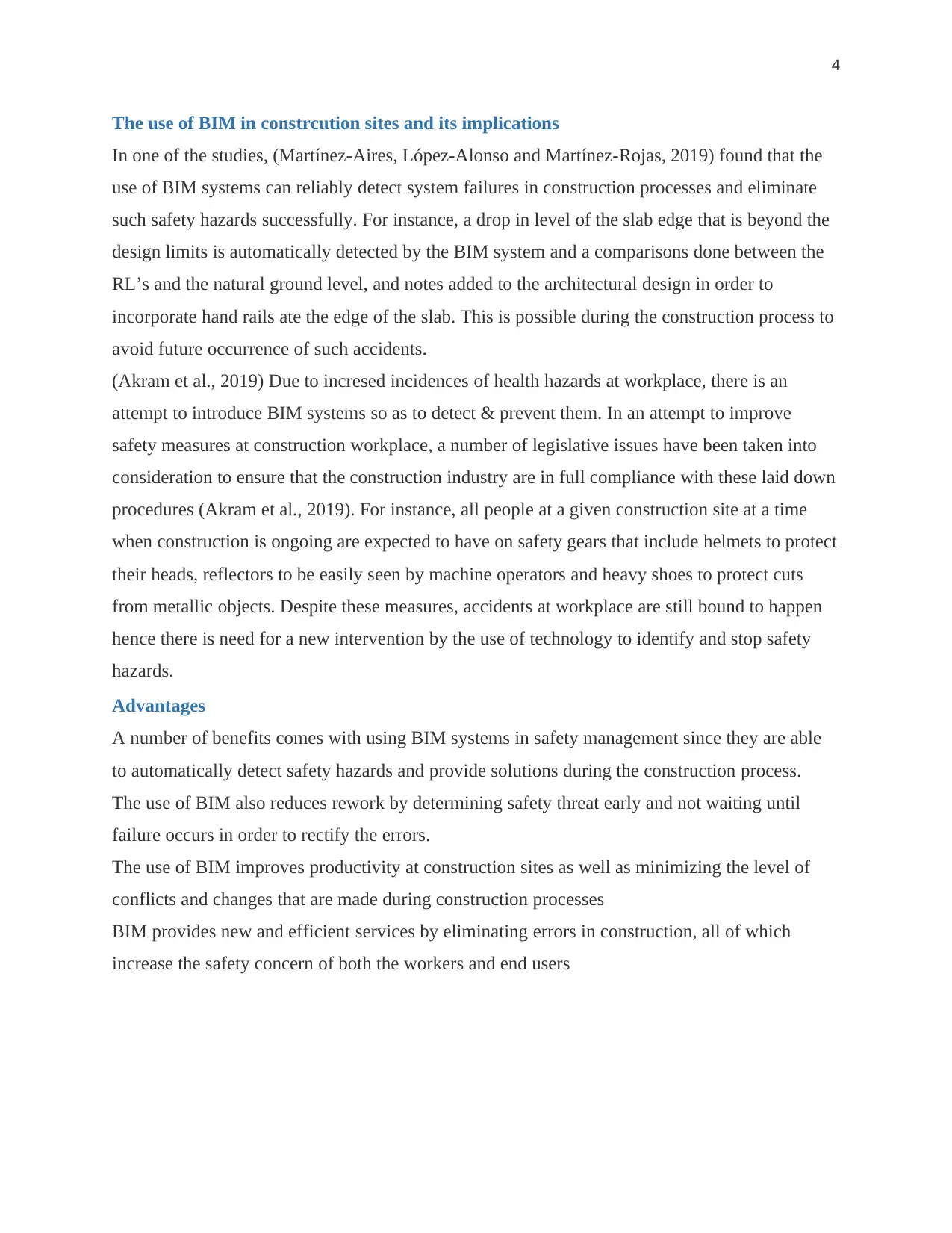
4
The use of BIM in constrcution sites and its implications
In one of the studies, (Martínez-Aires, López-Alonso and Martínez-Rojas, 2019) found that the
use of BIM systems can reliably detect system failures in construction processes and eliminate
such safety hazards successfully. For instance, a drop in level of the slab edge that is beyond the
design limits is automatically detected by the BIM system and a comparisons done between the
RL’s and the natural ground level, and notes added to the architectural design in order to
incorporate hand rails ate the edge of the slab. This is possible during the construction process to
avoid future occurrence of such accidents.
(Akram et al., 2019) Due to incresed incidences of health hazards at workplace, there is an
attempt to introduce BIM systems so as to detect & prevent them. In an attempt to improve
safety measures at construction workplace, a number of legislative issues have been taken into
consideration to ensure that the construction industry are in full compliance with these laid down
procedures (Akram et al., 2019). For instance, all people at a given construction site at a time
when construction is ongoing are expected to have on safety gears that include helmets to protect
their heads, reflectors to be easily seen by machine operators and heavy shoes to protect cuts
from metallic objects. Despite these measures, accidents at workplace are still bound to happen
hence there is need for a new intervention by the use of technology to identify and stop safety
hazards.
Advantages
A number of benefits comes with using BIM systems in safety management since they are able
to automatically detect safety hazards and provide solutions during the construction process.
The use of BIM also reduces rework by determining safety threat early and not waiting until
failure occurs in order to rectify the errors.
The use of BIM improves productivity at construction sites as well as minimizing the level of
conflicts and changes that are made during construction processes
BIM provides new and efficient services by eliminating errors in construction, all of which
increase the safety concern of both the workers and end users
The use of BIM in constrcution sites and its implications
In one of the studies, (Martínez-Aires, López-Alonso and Martínez-Rojas, 2019) found that the
use of BIM systems can reliably detect system failures in construction processes and eliminate
such safety hazards successfully. For instance, a drop in level of the slab edge that is beyond the
design limits is automatically detected by the BIM system and a comparisons done between the
RL’s and the natural ground level, and notes added to the architectural design in order to
incorporate hand rails ate the edge of the slab. This is possible during the construction process to
avoid future occurrence of such accidents.
(Akram et al., 2019) Due to incresed incidences of health hazards at workplace, there is an
attempt to introduce BIM systems so as to detect & prevent them. In an attempt to improve
safety measures at construction workplace, a number of legislative issues have been taken into
consideration to ensure that the construction industry are in full compliance with these laid down
procedures (Akram et al., 2019). For instance, all people at a given construction site at a time
when construction is ongoing are expected to have on safety gears that include helmets to protect
their heads, reflectors to be easily seen by machine operators and heavy shoes to protect cuts
from metallic objects. Despite these measures, accidents at workplace are still bound to happen
hence there is need for a new intervention by the use of technology to identify and stop safety
hazards.
Advantages
A number of benefits comes with using BIM systems in safety management since they are able
to automatically detect safety hazards and provide solutions during the construction process.
The use of BIM also reduces rework by determining safety threat early and not waiting until
failure occurs in order to rectify the errors.
The use of BIM improves productivity at construction sites as well as minimizing the level of
conflicts and changes that are made during construction processes
BIM provides new and efficient services by eliminating errors in construction, all of which
increase the safety concern of both the workers and end users
Paraphrase This Document
Need a fresh take? Get an instant paraphrase of this document with our AI Paraphraser
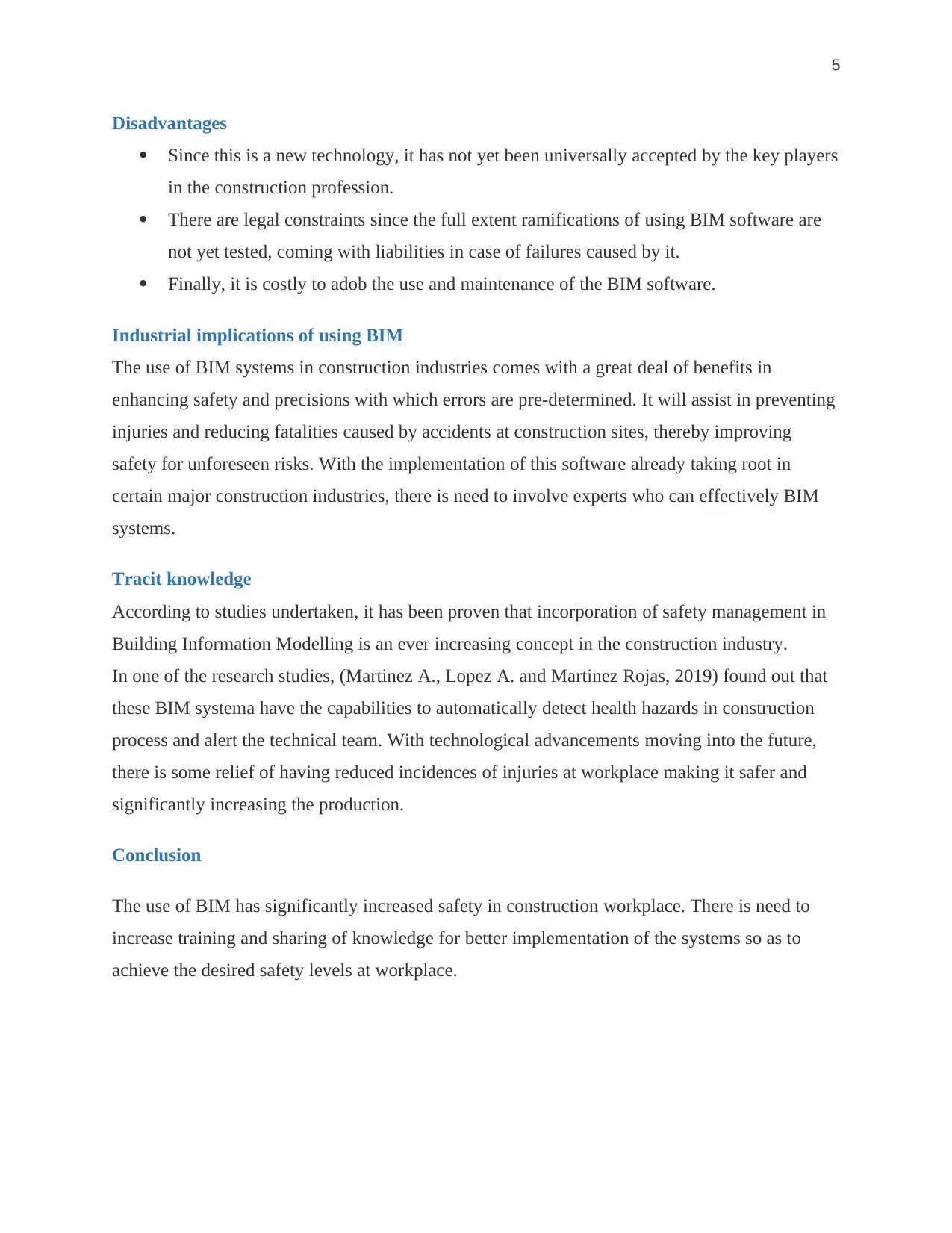
5
Disadvantages
Since this is a new technology, it has not yet been universally accepted by the key players
in the construction profession.
There are legal constraints since the full extent ramifications of using BIM software are
not yet tested, coming with liabilities in case of failures caused by it.
Finally, it is costly to adob the use and maintenance of the BIM software.
Industrial implications of using BIM
The use of BIM systems in construction industries comes with a great deal of benefits in
enhancing safety and precisions with which errors are pre-determined. It will assist in preventing
injuries and reducing fatalities caused by accidents at construction sites, thereby improving
safety for unforeseen risks. With the implementation of this software already taking root in
certain major construction industries, there is need to involve experts who can effectively BIM
systems.
Tracit knowledge
According to studies undertaken, it has been proven that incorporation of safety management in
Building Information Modelling is an ever increasing concept in the construction industry.
In one of the research studies, (Martinez A., Lopez A. and Martinez Rojas, 2019) found out that
these BIM systema have the capabilities to automatically detect health hazards in construction
process and alert the technical team. With technological advancements moving into the future,
there is some relief of having reduced incidences of injuries at workplace making it safer and
significantly increasing the production.
Conclusion
The use of BIM has significantly increased safety in construction workplace. There is need to
increase training and sharing of knowledge for better implementation of the systems so as to
achieve the desired safety levels at workplace.
Disadvantages
Since this is a new technology, it has not yet been universally accepted by the key players
in the construction profession.
There are legal constraints since the full extent ramifications of using BIM software are
not yet tested, coming with liabilities in case of failures caused by it.
Finally, it is costly to adob the use and maintenance of the BIM software.
Industrial implications of using BIM
The use of BIM systems in construction industries comes with a great deal of benefits in
enhancing safety and precisions with which errors are pre-determined. It will assist in preventing
injuries and reducing fatalities caused by accidents at construction sites, thereby improving
safety for unforeseen risks. With the implementation of this software already taking root in
certain major construction industries, there is need to involve experts who can effectively BIM
systems.
Tracit knowledge
According to studies undertaken, it has been proven that incorporation of safety management in
Building Information Modelling is an ever increasing concept in the construction industry.
In one of the research studies, (Martinez A., Lopez A. and Martinez Rojas, 2019) found out that
these BIM systema have the capabilities to automatically detect health hazards in construction
process and alert the technical team. With technological advancements moving into the future,
there is some relief of having reduced incidences of injuries at workplace making it safer and
significantly increasing the production.
Conclusion
The use of BIM has significantly increased safety in construction workplace. There is need to
increase training and sharing of knowledge for better implementation of the systems so as to
achieve the desired safety levels at workplace.
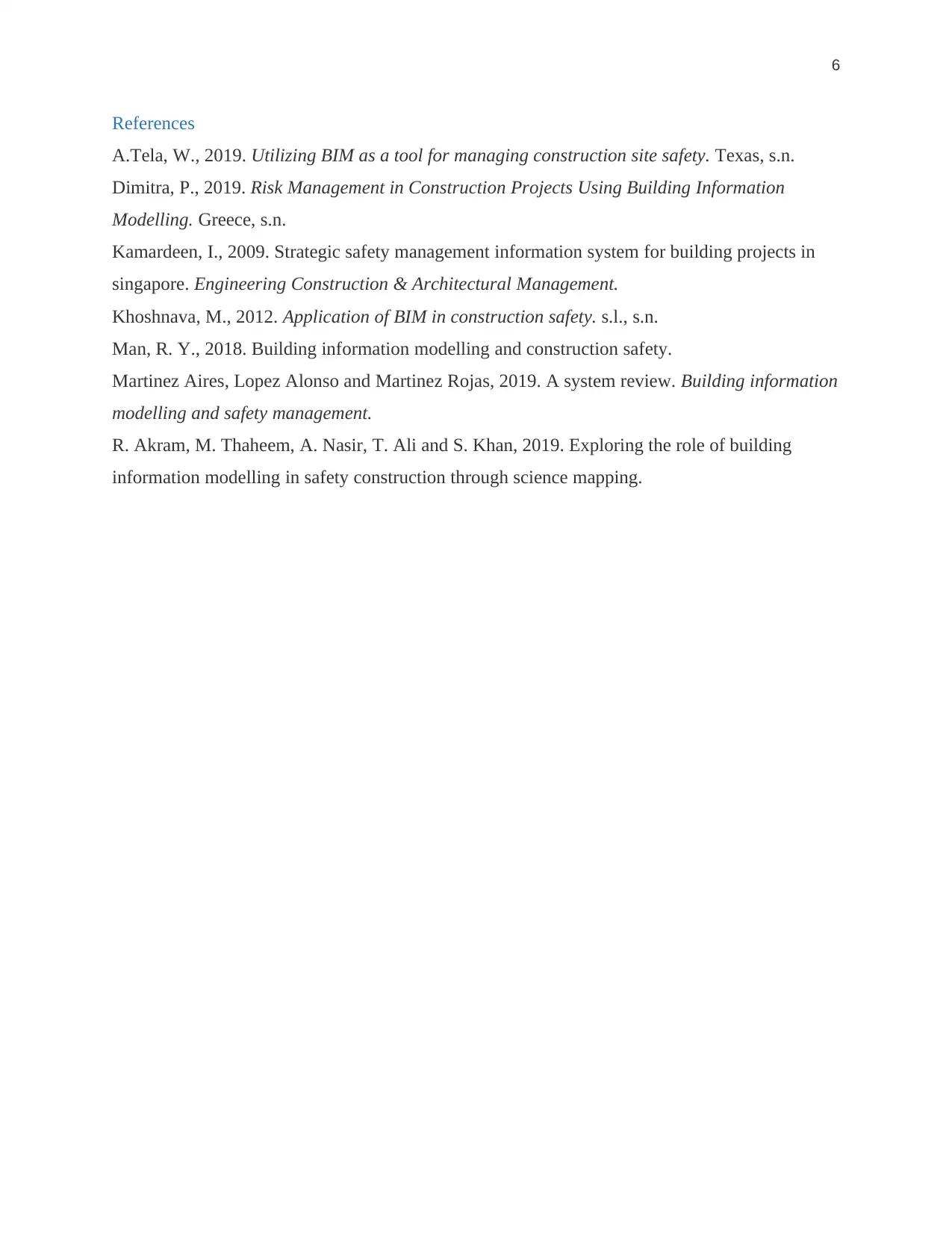
6
References
A.Tela, W., 2019. Utilizing BIM as a tool for managing construction site safety. Texas, s.n.
Dimitra, P., 2019. Risk Management in Construction Projects Using Building Information
Modelling. Greece, s.n.
Kamardeen, I., 2009. Strategic safety management information system for building projects in
singapore. Engineering Construction & Architectural Management.
Khoshnava, M., 2012. Application of BIM in construction safety. s.l., s.n.
Man, R. Y., 2018. Building information modelling and construction safety.
Martinez Aires, Lopez Alonso and Martinez Rojas, 2019. A system review. Building information
modelling and safety management.
R. Akram, M. Thaheem, A. Nasir, T. Ali and S. Khan, 2019. Exploring the role of building
information modelling in safety construction through science mapping.
References
A.Tela, W., 2019. Utilizing BIM as a tool for managing construction site safety. Texas, s.n.
Dimitra, P., 2019. Risk Management in Construction Projects Using Building Information
Modelling. Greece, s.n.
Kamardeen, I., 2009. Strategic safety management information system for building projects in
singapore. Engineering Construction & Architectural Management.
Khoshnava, M., 2012. Application of BIM in construction safety. s.l., s.n.
Man, R. Y., 2018. Building information modelling and construction safety.
Martinez Aires, Lopez Alonso and Martinez Rojas, 2019. A system review. Building information
modelling and safety management.
R. Akram, M. Thaheem, A. Nasir, T. Ali and S. Khan, 2019. Exploring the role of building
information modelling in safety construction through science mapping.
⊘ This is a preview!⊘
Do you want full access?
Subscribe today to unlock all pages.

Trusted by 1+ million students worldwide
1 out of 6
Related Documents
Your All-in-One AI-Powered Toolkit for Academic Success.
+13062052269
info@desklib.com
Available 24*7 on WhatsApp / Email
![[object Object]](/_next/static/media/star-bottom.7253800d.svg)
Unlock your academic potential
Copyright © 2020–2025 A2Z Services. All Rights Reserved. Developed and managed by ZUCOL.




